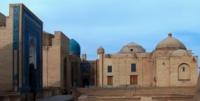You are here
Northern group monument of Shakhi-i-Zinda.


Excursions to monuments history of necropolis Shakhi-Zinda.
“… so let Allah prolong their eternity to make the tomb lit garden of happiness of Khodja-Ahmad, which did know equal to him by beauty …“
On the left portal pylon, the inscription reads.
Coach trip from Samadkand to Tashkent.
In the 1340s, at the upper point of the necropolis was built the mausoleum of Khodja-Ahmad, which finished the path, becoming a central axis of Shahi-Zinda. We have no historical data on Khodja-Ahmad.
However, obviously, he was a significant spiritual figure in Samarkand. On the left portal pylon, the inscription reads: “ … so let Allah prolong their eternity to make the tomb lit garden of happiness of Khodja-Ahmad, which did know equal to him by beauty …“.
On the portal arch there are lines from Persian verses: “If you were Shah of Iraq and king of China, your end (anyhow) would be here - under the ground. What for do you attach your heart to this perishable world if the end of all your matters would be such?”.
In 1361, the new mausoleum was built to the right of Khodja-Ahmad's mausoleum. Fragments of the text on the portal allow to guess, that it was a tomb of some noble married woman.
According to Abu-Takhir-khodja, she might be one of Amir Temur's wives, but there are no reliable evidences for that fact. These early mausoleums have a form of single-chamber, portal-dome buildings with exquisite decor from enameled terracotta.
Characteristic colors: bluish green, ashen-blue and manganese-coloured. Technique and colours of glazes remind panels at the mausoleum of Nadjm ad-Din Qubro, built in 1320s-1330s.
Under the floors of both mausoleums, there are burial chambers, structurally separated from aboveground space of the buildings.
Authority:
Alexey Arapov. Samarkand. Masterpieces of Central Asia. Tashkent, San’at. 2004
Photos
Alexander Petrov.







